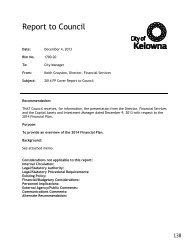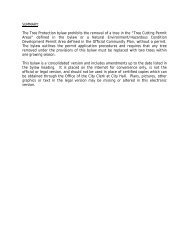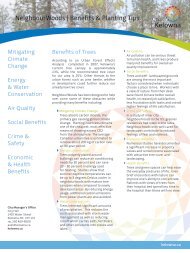Comprehensive Site Development Plan ... - City of Kelowna
Comprehensive Site Development Plan ... - City of Kelowna
Comprehensive Site Development Plan ... - City of Kelowna
Create successful ePaper yourself
Turn your PDF publications into a flip-book with our unique Google optimized e-Paper software.
Avocets at Glenmore Landfill<br />
4<br />
to be used for mitigation, nesting islands would need to be constructed and trees cleared to<br />
provide open space around the wetland.<br />
Sexsmith Wetlands are open, privately-owned fields bounded by Sexsmith Road to the north,<br />
Longhill Road to the west and Campion Road industrial area to the east. The field is devoid <strong>of</strong><br />
trees and appears to be a suitable location for creation <strong>of</strong> compensation habitat for avocets. A<br />
relatively small 7-10 ha wetland would take up only a fraction <strong>of</strong> the total area. The site is gently<br />
sloping and cattail marshes presently occur along a drainage, which suggests natural potential for<br />
a wetland. The site would need to be assessed to see if an alkali evaporation pan could be built<br />
there, and how much earth works might be required. Alterations to the present surrounding<br />
habitat would be unnecessary because it is presently very open and likely suitable (in general) for<br />
avocets. Soil substrates appear to be clay but would have to be assessed. A natural gas pipeline<br />
occurs to one side <strong>of</strong> the field and would have to be avoided (Weir and Gyug 1999).<br />
Fields south <strong>of</strong> Duck Lake may have potential for compensation habitat but further assessment<br />
is warranted. The large open meadows and hayfields occur to the south and south east <strong>of</strong> Duck<br />
Lake.<br />
2.5 Potential compensation habitat elsewhere in British Columbia<br />
One other nesting colony <strong>of</strong> avocets has been discovered in British Columbia, at Little White<br />
Lake near Clinton. Habitat enhancement work could be conducted at this site, mainly related to<br />
exclusion <strong>of</strong> cattle (Weir and Gyug 1999). Other colonies potentially occur in the southern<br />
Cariboo as there is a very high concentration <strong>of</strong> alkali lakes in the vicinity <strong>of</strong> Clinton and 70-Mile<br />
House (Renaut 1993). Funding <strong>of</strong> surveys for possible colonies could be viewed as partial<br />
mitigation for the eventual loss <strong>of</strong> the Glenmore Landfill site.<br />
3. Conservation <strong>Plan</strong><br />
3.1 The future <strong>of</strong> the American Avocet in the <strong>Kelowna</strong> area.<br />
Because the risk <strong>of</strong> extirpation is so high (one catastrophic event or cumulative smaller effects,<br />
from continued expansion and operation <strong>of</strong> the landfill, could easily result in extirpation <strong>of</strong> the<br />
colony), I believe the best approach is to implement a conservative conservation plan. The main<br />
initiatives <strong>of</strong> the plan would be to:<br />
1. Immediately attempt to establish a breeding colony at Robert Lake (see 3.2).<br />
2. At the same time, provide alternative breeding habitat (nesting platforms) at other sites near<br />
Glenmore Landfill, such as Slough No. 2 and Bubna Slough (see 3.3).<br />
3. Maintain existing wetland habitat at the Glenmore Landfill for breeding avocets while<br />
assessing the success <strong>of</strong> providing alternative <strong>of</strong>fsite habitats (see 3.4).<br />
4. If attempts to encourage avocets to breed elsewhere fail, engineer an onsite wetland to<br />
provide breeding habitat for breeding American Avocets that will also serve landfill water<br />
management purposes (see 3.5).<br />
Manning, Cooper and Associates

















